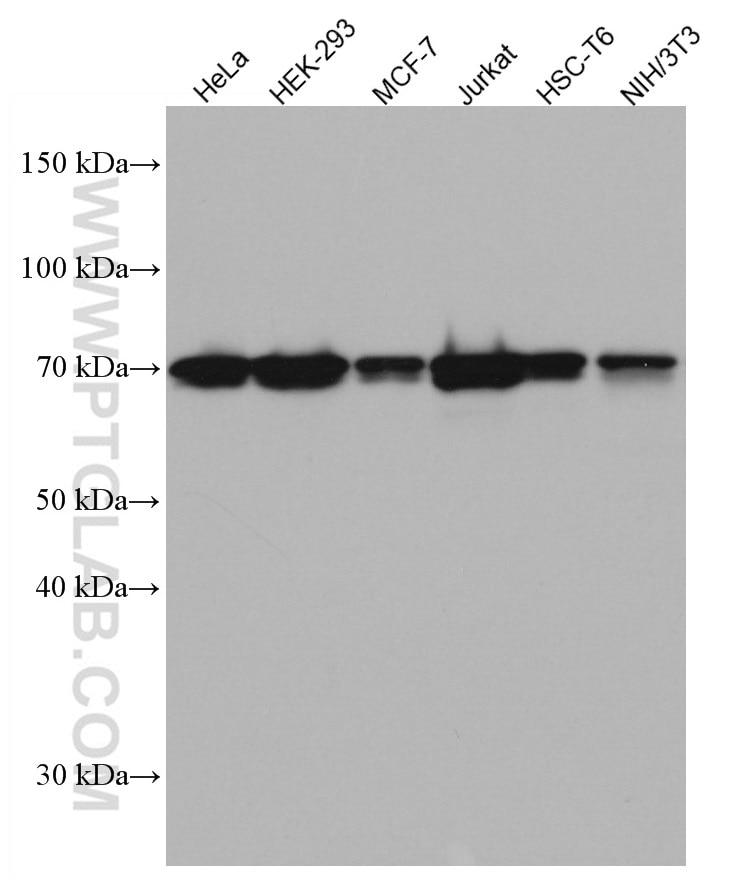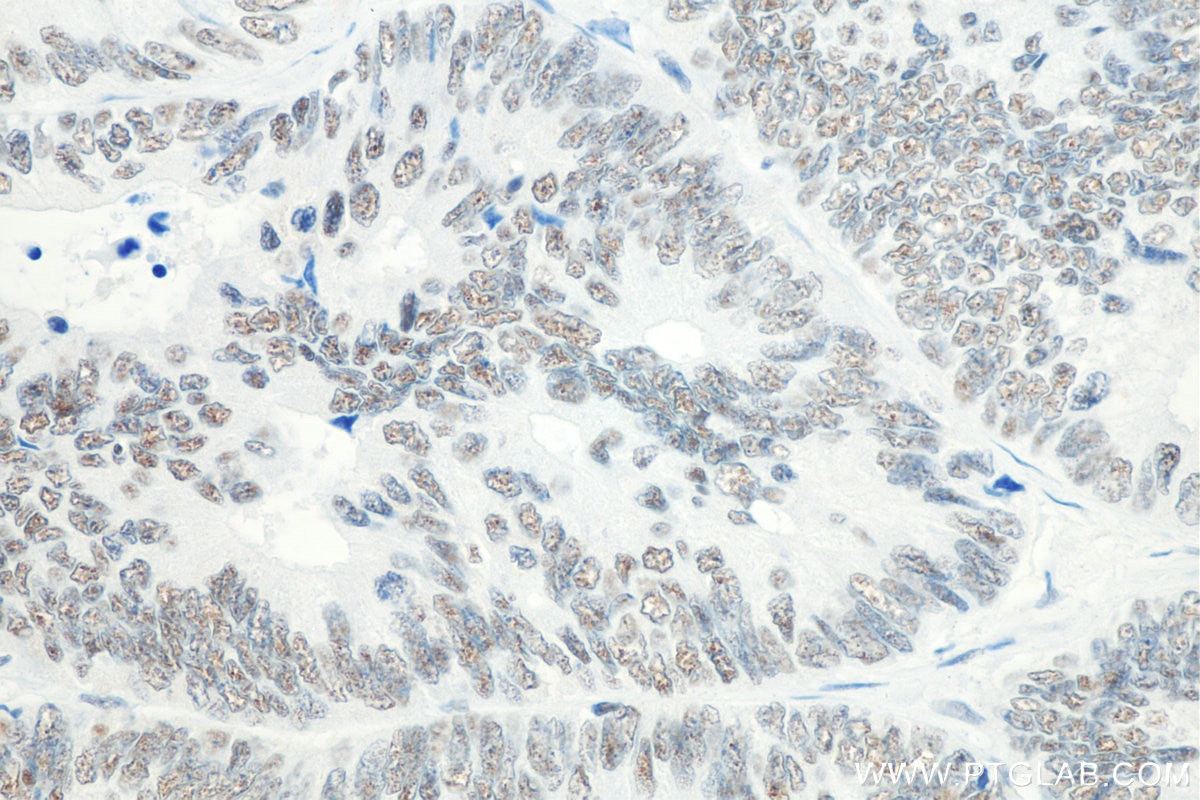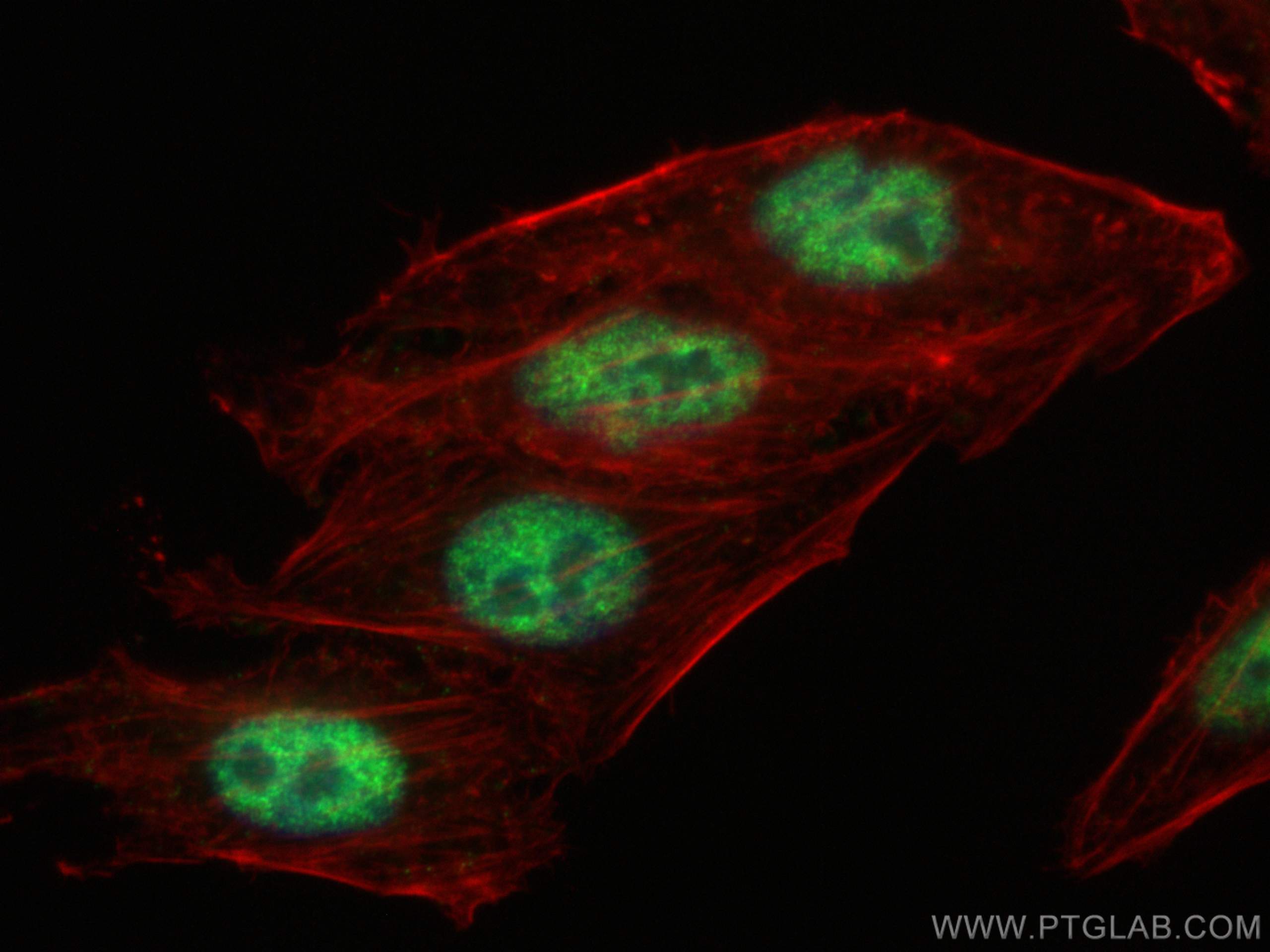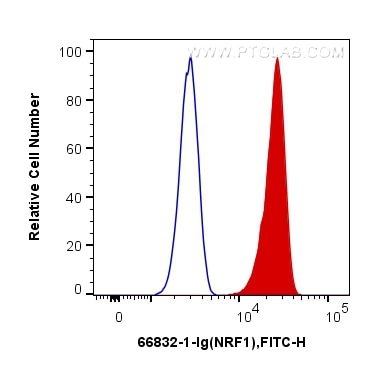Anticorps Monoclonal anti-NRF1/nuclear respiratory factor 1
NRF1/nuclear respiratory factor 1 Monoclonal Antibody for WB, IHC, IF/ICC, FC (Intra), ELISA
Hôte / Isotype
Mouse / IgG2b
Réactivité testée
Humain, rat, souris et plus (1)
Applications
WB, IHC, IF/ICC, FC (Intra), ELISA
Conjugaison
Non conjugué
CloneNo.
3C2B8
N° de cat : 66832-1-Ig
Synonymes
Galerie de données de validation
Applications testées
| Résultats positifs en WB | cellules HeLa, cellules HEK-293, cellules HSC-T6, cellules Jurkat, cellules MCF-7, cellules NIH/3T3 |
| Résultats positifs en IHC | tissu de cancer du côlon humain, il est suggéré de démasquer l'antigène avec un tampon de TE buffer pH 9.0; (*) À défaut, 'le démasquage de l'antigène peut être 'effectué avec un tampon citrate pH 6,0. |
| Résultats positifs en IF/ICC | cellules HepG2, |
| Résultats positifs en FC (Intra) | cellules HepG2 |
Dilution recommandée
| Application | Dilution |
|---|---|
| Western Blot (WB) | WB : 1:5000-1:50000 |
| Immunohistochimie (IHC) | IHC : 1:500-1:2000 |
| Immunofluorescence (IF)/ICC | IF/ICC : 1:200-1:800 |
| Flow Cytometry (FC) (INTRA) | FC (INTRA) : 0.20 ug per 10^6 cells in a 100 µl suspension |
| It is recommended that this reagent should be titrated in each testing system to obtain optimal results. | |
| Sample-dependent, check data in validation data gallery | |
Applications publiées
| WB | See 12 publications below |
| IHC | See 1 publications below |
Informations sur le produit
66832-1-Ig cible NRF1/nuclear respiratory factor 1 dans les applications de WB, IHC, IF/ICC, FC (Intra), ELISA et montre une réactivité avec des échantillons Humain, rat, souris
| Réactivité | Humain, rat, souris |
| Réactivité citée | rat, Humain, poulet, souris |
| Hôte / Isotype | Mouse / IgG2b |
| Clonalité | Monoclonal |
| Type | Anticorps |
| Immunogène | NRF1/nuclear respiratory factor 1 Protéine recombinante Ag28149 |
| Nom complet | nuclear respiratory factor 1 |
| Masse moléculaire calculée | 522 aa, 56 kDa |
| Poids moléculaire observé | 70 kDa |
| Numéro d’acquisition GenBank | BC016925 |
| Symbole du gène | NRF1 |
| Identification du gène (NCBI) | 4899 |
| Conjugaison | Non conjugué |
| Forme | Liquide |
| Méthode de purification | Purification par protéine A |
| Tampon de stockage | PBS with 0.02% sodium azide and 50% glycerol |
| Conditions de stockage | Stocker à -20°C. Stable pendant un an après l'expédition. L'aliquotage n'est pas nécessaire pour le stockage à -20oC Les 20ul contiennent 0,1% de BSA. |
Informations générales
NRF1, also named as Alpha-pal and NRF-1, belongs to the NRF1/Ewg family. It is a transcription factor that activates the expression of the EIF2S1 (EIF2-alpha) gene. NRF1 is implicated in the control of nuclear genes required for respiration, heme biosynthesis, and mitochondrial DNA transcription and replication. It plays a critical role in regulating the expression of many antioxidant response element (ARE)-dependent genes. NRF1 exists various isoforms and long isoform is about 67 kDa and short isoform is about 45 kDa.
Protocole
| Product Specific Protocols | |
|---|---|
| WB protocol for NRF1/nuclear respiratory factor 1 antibody 66832-1-Ig | Download protocol |
| IHC protocol for NRF1/nuclear respiratory factor 1 antibody 66832-1-Ig | Download protocol |
| IF protocol for NRF1/nuclear respiratory factor 1 antibody 66832-1-Ig | Download protocol |
| Standard Protocols | |
|---|---|
| Click here to view our Standard Protocols |
Publications
| Species | Application | Title |
|---|---|---|
Cell Death Dis S100A8/A9hi neutrophils induce mitochondrial dysfunction and PANoptosis in endothelial cells via mitochondrial complex I deficiency during sepsis | ||
Life Sci NRF1-induced mmu_circ_0001388/hsa_circ_0029470 confers ferroptosis resistance in ischemic acute kidney injury via the miR-193b-3p/TCF4/GPX4 axis | ||
J Clin Transl Hepatol Icaritin Attenuates Lipid Accumulation by Increasing Energy Expenditure and Autophagy Regulated by Phosphorylating AMPK. | ||
PLoS One Supplementation with dietary omega-3 PUFA mitigates fetal brain inflammation and mitochondrial damage caused by high doses of sodium nitrite in maternal rats. | ||
Nitric Oxide Hydrogen sulfide alleviates heart failure with preserved ejection fraction in mice by targeting mitochondrial abnormalities via PGC-1α | ||
J Pharm Pharmacol Styrax (Liquidambar orientalis Mill.) promotes mitochondrial function and reduces cardiac damage following myocardial ischemic injury: the role of the AMPK-PGC1α signaling pathway |





